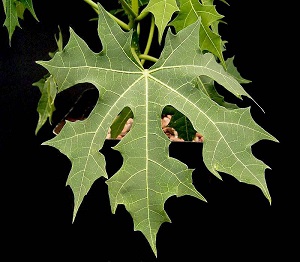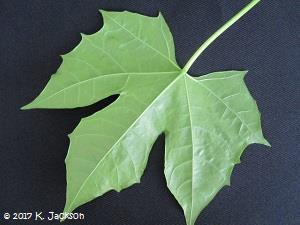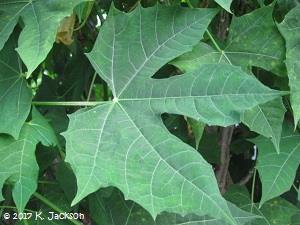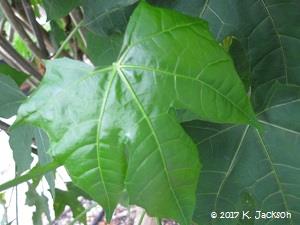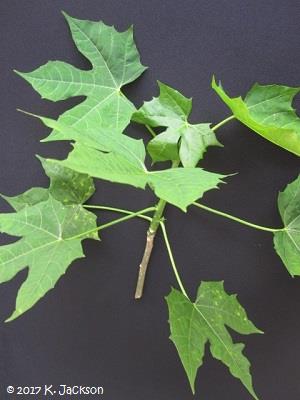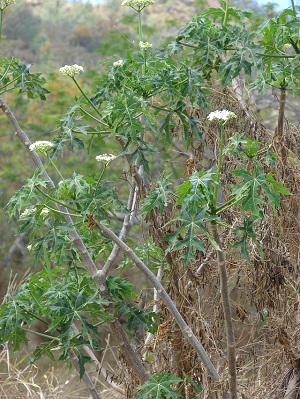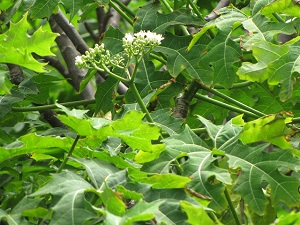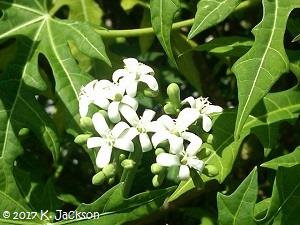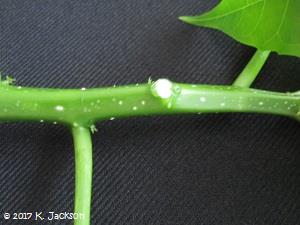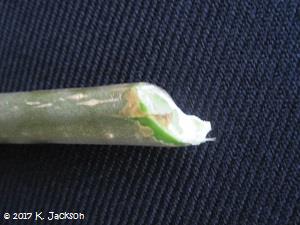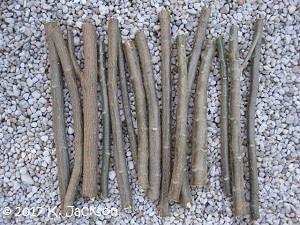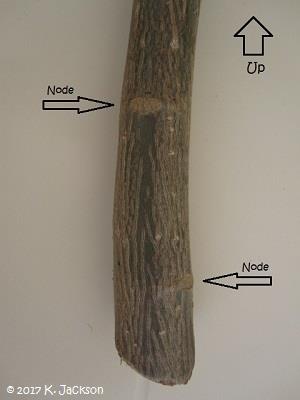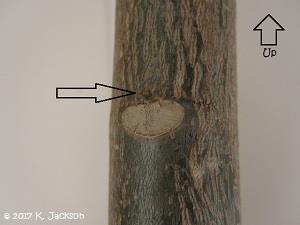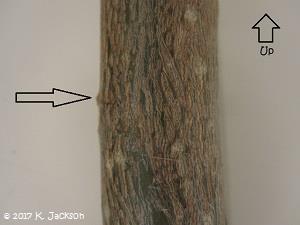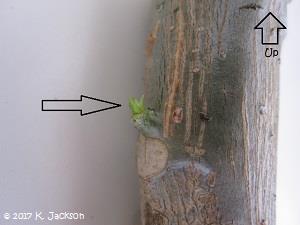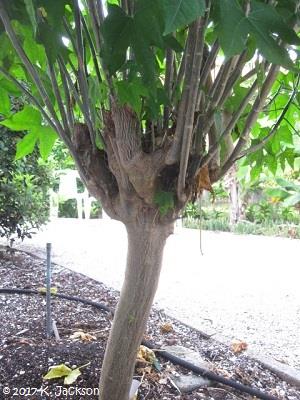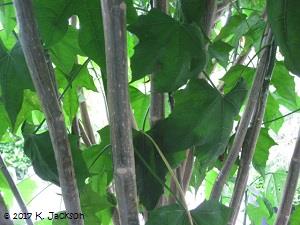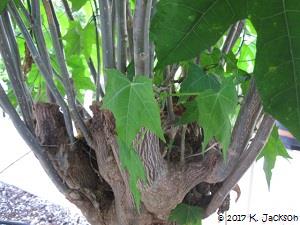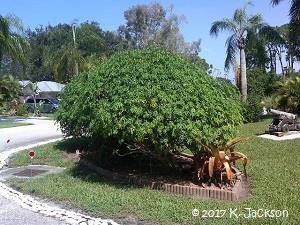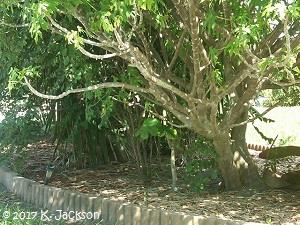| Chaya, Tree Spinach - Cnidoscolus spp. | ||||||||||||||||||||||||||||||||||||||||||||||||||||||||||||||||||||||||||||||||||||||||||||||||||||||||||||||
|---|---|---|---|---|---|---|---|---|---|---|---|---|---|---|---|---|---|---|---|---|---|---|---|---|---|---|---|---|---|---|---|---|---|---|---|---|---|---|---|---|---|---|---|---|---|---|---|---|---|---|---|---|---|---|---|---|---|---|---|---|---|---|---|---|---|---|---|---|---|---|---|---|---|---|---|---|---|---|---|---|---|---|---|---|---|---|---|---|---|---|---|---|---|---|---|---|---|---|---|---|---|---|---|---|---|---|---|---|---|---|
 Fig. 1  Cnidoscolus aconitifolius (Spinach tree, chaya). Leaf. Waianapanapa, Maui, Hawaii. Also known as Jatropha aconitifolia 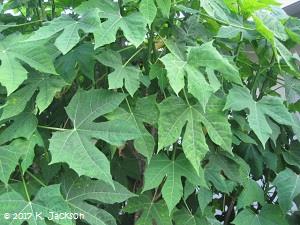 Fig. 2  Tree spinach leaves 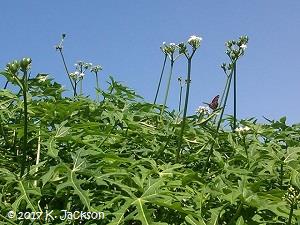 Fig. 9  Long flower stems and butterfly, Venice, Florida 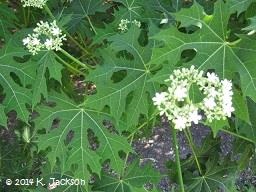 Fig. 10  Flowers and leaves Fruit and Spice Park, Florida 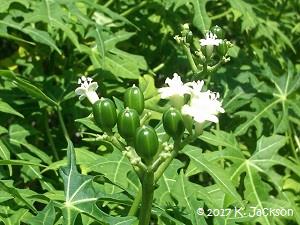 Fig. 11  Juvenile seed pods Venice, Florida 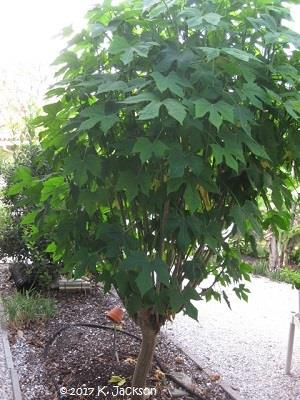 Fig. 15  Three year old plant, pollarded at about 3 ft (1 m)  Fig. 16  Fruit and Spice Park, Florida Fig. 29  Chaya leaves washed and ready to cook  Fig. 30  Papadzules, a traditional Yucatecan dish, at La Chaya Maya Restaurante in Mérida, Yucatán 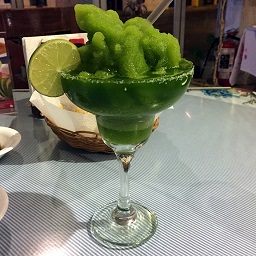 Fig. 31  Chaya margarita at La Chaya Maya, Mexico Fig. 32  Chaya soup: onions, garlic, stock, garnished with yougurt, garlic chives and flowers |
Scientific
name Cnidoscolus aconitifolius (Mill.) I.M. Johnst. and C. chayamansa McVaugh 1,5 Pronunciation kah-knee-doe-SKOHL-us a-kon-eye-tih-FOH-lee-us 10 Common names C. chayamansa McVaugh: English: tree-spinach; Spanish: chaya, chayamansa; Swedish: chaya; Unknown: chaya col, chaykeken, kikilchay C. aconitifolius (Mill.) I.M. Johnst.: English: cabbage-star, tree-spinach, tread softly; French: manioc bâtard; Spanish: chaya, copapayo 1,3,11 Synonyms C. aconitifolius subsp. aconitifolius; C. chaya Lundell; C. chayamansa McVaugh; C. fragrans (Kunth) Pohl; C. longipedunculatus (Brandegee) Pax & K.Hoffm.; C. napifolius (Desr.) Pohl; C. palmatus (Willd.) Pohl; C. quinquelobatus (Mill.) León; Jatropha aconitifolia Mill.; J. aconitifolia var. multipartita Müll.Arg.; J. aconitifolia var. palmata (Willd.) Müll.Arg.; J. aconitifolia var. papaya (Medik.) Pax; J. deutziiflora Croizat; J. fragrans Kunth; J. longipedunculata Brandegee; J. napifolia Desr.; J. palmata Willd.; J. palmata Sessé & Moc. ex Cerv.; J. papaya Medik.; J. quinqueloba Sessé; J. quinquelobata Mill.; J. urens var. inermis Calvino; J. urens var. longipedunculata Brandegee 4 Relatives Cassava, Manihot spp. and Jatropha spp. Family Euphorbiaceae Origin Mexico (Yucatán), Belize, El Salvador, Guatemala, Honduras, Nicaragua 1 USDA hardiness zones 9-11 Tropical wet or dry 2 Uses Food; living fence; medicinal; ornamental; compost; mulch Height 6.5-20 ft (2-6 m) 3 Plant habit Large leafy shrub Growth rate Vigorous Longevity Perennial Trunk/bark/branches Multi-stemmed when pruned Pruning requirement Keep to 5-8 ft (1.5-2.5 m) for ease of harvesting Leaves Evergreen, dark green, alternate, simple; palmately lobed; 6-8 in. (14-20 cm) across; borne on a long slender petiole 5 Flowers Small, white; male and female flowers are borne at the end of long flower stems 5 Light requirement Full sun, tolerates shade Photoperiod Short day (<12 hrs) 2 Soil tolerances Tolerant of a wide range of well drained soils pH preference 5.5-6.5 2 Drought tolerance Some drought tolerated Soil salt tolerance Not salt tolerant 3 Soil depth for planting Medium 20-60 in. (50-150 cm); shallow 8-20 in. (20-50 cm) Cold tolerance Tropical; tolerant to 54°F (12 °C) 2 Plant spacing 10 ft (3 m); living fence: 3 ft (1m); commercial production: 3-6.5 ft (1-2 m) 9 Invasive potential * None reported Pest/disease resistance Chaya is quite insect and disease resistant Known hazard The raw chaya plant contains cyanogenic glycosides, sources of cyanide poisoning; always cook it; vertebrate poisons: mammals, birds 2 The sticky sap may cause skin irritation to some people. Reading Material Chaya—Cnidoscolus chayamansa McVaugh, University of Florida pdf Plant of the month: Chaya. Mayan Tree-Spinach by Arthur Lee Jacobson Cnidoscolus aconitifolius: Tree Pot Herb, Eat the Weeds Some Cnidoscolus species have been classified as Jatropha but are now considered Cnidoscolus. C. chayamansa McVaugh, has also been called C. aconitifolius (Mill.) I.M. Johnst. Sorting Cnidoscolus Names from the Multilingual Multiscript Plant Name Database, University of Melbourne, Australia ext. link Distribution Originally, most likely, from Northern America: Mexico, and Central America: Belize; El Salvador; Guatemala; Honduras; Nicaragua. Cultivars have been distributed to Cuba, Florida, other parts of Mexico, and the Southwest United States. From their document, Echo has been distributing their non-stinging cultivar to a number of countries, Africa and parts of Asia, Kenya, Philippines, Hawaii, Zambia, Bolivia, Tanzania, Brazil, Dominican Republic, Bahamas, Indonesia, and has received information on chaya's trials, growth, and successes and failures. 6 Description Chaya, an important perennial vegetable, is a vigorous and attractive large leafy shrub, particularly tolerant of poor growing conditions. Leaves Dark green, alternate, simple, slick surfaced often with some hairs, and palmately lobed (much like the leaves of okra). Each leaf is 6 to 8 inches across and is borne on a long slender petiole (leaf stem). Where the leaf stem connects to the leaf, the leaf veins are fleshy and cuplike. The wood of young stems is soft, easily broken, and susceptible to rot. When cut, the stem exudes a white latex (Fig. 17,18). 5
Fig. 3. C. chayamansa. Chaya leaf. The type found in Florida has five lobes. 5 Fig. 4. Chaya leaf Fig. 5. Chaya leaf, underneath Fig. 6. Mature chaya leaf Fig. 7. Immature chaya leaf Fig. 8. New growth Flowers Chaya blooms frequently, and both male and female flowers are borne together at the end of long flower stems. Both kinds of flowers are small, less than 10 mm long. The male flowers are much more abundant. In the fall trials at Gainesville, FL, seed pods about 1-inch wide and the size of walnuts were produced. 5
Fig. 12. C. aconitifolius (Spinach tree, chaya). Flowers and leaves. Ulupalakua, Maui, Hawaii Fig. 13. C. aconitifolius (Spinach tree, chaya). Flowers and leaves. Waianapanapa, Maui, Hawaii Fig. 14. Flowers, Venice, Florida Fruit None edible. Seed pods are about 1-inch wide, and the size of walnuts in the fall trials at Gainesville, FL. 5 Varieties Wild chaya is not as popular because of its stinging hairs. Cultivated varieties differ in the degree of lobing of the leaves, the size of the leaf, and quantity of the stinging hairs. 'Chayamansa.' 'Estrella' without stinging hairs, faster growing with deeply lobed leaves 7 'Hog' is a large leaf cultivar, no stinging hairs and is said to be similar to those served in Mexican restaurants. 7 'Pig' chaya, sometimes known as keken-chay, is one of the very best eating varieties. It has small leaves, with three shallow lobes and almost no spines. 'Picuda.' 'Redonda.' 5 Harvesting Once established leaves and pieces of tender and succulent stem can be harvested for cooking. The sap may cause skin irritation to some people. The first harvest may take place after 90 - 120 days 2 Sixty percent or more of the leaves may be removed at harvest, with enough left for healthy new growth. Since most gardeners need only a few leaves at a time, one plant harvested on a continuous basis is adequate. 5
Fig. 17,18. Sticky, white milky sap Crop cycle Year round. 2 Propagation Chaya is propagated by stem cuttings. To prepare cuttings take a 6-12 inch (15-30 cm) length section of a woody stem containing 2-3 nodes. Cuttings can be taken from either the top or the bottom portion of a stem, but it must be woody. Cuttings from the top portion of the stems have less problems with rotting during the rooting process. The soft, green growing tips should be avoided. Remove all leaves and air dry the cuttings in the shade for 3-4 days before planting. This will allow the cut ends to seal, making them less susceptible to rotting. Cuttings can be planted directly in the ground, or in nursery containers and transplanted to the field. Cuttings planted directly in the ground are more susceptible to rotting. Cuttings should be planted with 1-2 nodes beneath the soil and kept moist. It is important not to over water the cuttings, because this will increase rotting. Cuttings are ready for transplanting when mature leaves are produced. Edible greenery is produced within 3-5 months. 8 For detailed information please refer to Echo Technical Notes, Chaya. 6
Fig. 19. Woody cuttings 6-12 in. (15-30 cm) long, allow to air dry for 3 to 4 days in the shade Fig. 20. Plant 1 to 2 nodes beneath the soil, be careful to plant the correct way up Fig. 21. Dormant axillary bud is above the leaf scar Fig. 22. Side view, it may be possible to feel the raised axillary bud Fig. 23. Axillary bud beginning to grow Planting Planting distance should be at least 10 ft (3 m). It is cold sensitive and should be planted at the beginning of a warm season. The optimal growing temperature is 68-90 °F (20-32 °C), and the absolute temperature range is 54-100 °F (12-38 °C). 2 To create a living fence, plant rooted cutting every 3 ft (1m). For commercial production, rows of chaya should be planted 3-6.5 ft (1-2 m) apart, with 3 ft (1m) between plants in a row. 9 Irrigation Irrigate during dry periods. Pruning It is a good idea to prune periodically to promote new growth. Try pruning styles such as pollarding or coppicing to produce a good quantity of young growth for harvesting. Pollard is a European traditional term for cutting off the upper branches of a tree to encourage new growth at the top, thus promoting a dense head of branches and foliage. Copice is also a European traditional term for woodland management, where particular trees make new growth from the stump or the roots if cut down. Young tree stems are periodically or regularly cut down to ground level.
Fig. 24,25. Last season's growth from the pollarded area, Sarasota, Florida Fig. 26. Close-up of growth from the pollarded area, Sarasota, Florida Fig. 27. Natural rounded form of chaya shrub, Venice, Florida Fig. 28. Growth habit: trunk/branches, Venice, Florida Fertilizing and Irrigation Regular fertilizer application and irrigation will increase the quantity and quality of leaves. Pests Tomato hornworms can rapidly defoliate a young plant, however it will rejuvenate new leaves. Fungal (e.g., rust) or broad mite pests are usually seasonal. 6 Tobacco Hornworm, Manduca sexta (Linnaeus), and Tomato Hornworm, Manduca quinquemaculata (Haworth), (Insecta: Lepidoptera: Sphingidae) from the University of Florida pdf Disease Chaya is a host of CCMV (Cassava Common Mosaic Virus) although plant materials are available from none-infected sources. Food Uses Though the diversity of uses of chaya as a food is unknown in pre-Hispanic times, modern usage of chaya is rather diverse. Although the larger mature leaves are preferred for use as wraps, generally the young, tender leaves and apical shoots are eaten. Often chaya leaves are eaten after boiling them in water with salt, with or without the apical shoots and sometimes with petioles. Likewise, chaya greens are frequently combined with other vegetables and/or meat in soups and stews. Boiled chaya greens, covered with ground roasted pepita seeds (Cucurbita sp.), cooked tomato and chile (Capsicum sp.) are eaten as a sort of burrito in a corn tortilla. 13 The most famous chaya dish is probably Dzotobilchay, consisting of diced chaya leaves mixed with nixtamalized corn dough, covered with sauce or vegetables and diced eggs, then wrapped in banana leaves or other chaya leaves, and cooked to make a tamale. Other popular Yucatec dishes include Pibxcatic, or stuffed chiles served over chaya leaves (de Caraza Campos and Luna Parra 1994), and Brazos de la Reina, made by rolling chaya leaves in corn dough, which is then steamed and served with tomato and squash seeds. 13 Some people fry previously boiled chaya leaves and mix them with eggs, onions, and tomatoes, or cook the leaves on a hot clay pan (comal) and add them to salads. Most people consume cooked chaya leaves, and the leaves are only rarely eaten raw as fresh greens. A popular drink in the Yucatán peninsula is made by blending raw chaya leaves in sugar water with lemons, pineapple, and other fruits and sold to tourists as chayagra, along with claims of heightened virility. 13 Chaya, compared with spinach (Spinacia oleracea), retains it's texture somewhat and it's volume, so much less is required for a recipe. Like spinach it can be canned or frozen. 2
Fig. 33. Chaya boiled without the lid for 10 to 20 minutes Fig. 34. Chaya cooked, drained, excess water squeezed out Fig. 35. Chopped chaya Fig. 36. Chaya divided into portions for freezing Fig. 37. Cooking chaya soup, see Fig. 32 Toxicity Chaya leaves contain toxic hydrocyanic glycosides (HCN). Always cook chaya and avoid breathing the vapors as the HCN boils off as a gas. The stinging hairs (if present) and toxicity are destroyed when cooked and so the cooking liquid is fine to drink. As with spinach always use non-reactive cookware (non-aluminum). Nutrition The leaves are very high in protein, calcium, iron, carotene and vitamins A, B and C. 6 The amino acids in chaya are well balanced, which is even more important for those in impoverished parts of the world, who have a diet low in protein. The nutritional value of chaya leaves is highly regarded in Yucatán-primarily for its protein-and is sometimes seen as a suitable replacement for meat. Several informants explained that in the past, when meat was scarce or expensive, chaya was much more popular. But as the price of meat has dropped in modem times, chaya has decreased in popularity. Adding to this, chaya suffers from being seen by many of the younger generations as a food of the poor, a stigma which by no means augments its popularity. We also received reports of people eating wild chaya leaves-boiled to remove the spines and toxins-in times of extreme scarcity. The use of wild chaya as a famine food is confirmed by in the 16th century Maya text of Chilam Balam of Chumayel (Roys 1967) and in 16th century Spanish chronicles (Marcus 1982). 13 Serving Size: 1/2 cup (1OOg) fresh leaves
Honolulu, HI. Comparisons of nutritional compositions of leaves of chaya (C. chayamansa McVaughn) and spinach (Spinacia oleracea L.) per 100 g fresh weight.
Chaya - High Nutrition Perennial from www.usaid.gov pdf Medicinal Properties ** Blood system applications, digestive system applications, sensory applications, immune system applications, respiratory applications, muscular/skeletal applications. 2 Usually cooked leaves are eaten. Teas or infusions are made from the leaves. 6 Other Uses A very good mulch for vegetable gardens where it provides high minerals and nitrogen. Chaya makes an excellent fast growing edible, living fence. The flowers attract pollinators. Economic Importance Because of it's ability to grow well in poor growth conditions (either arid or rainy, and sunny or shady), high nutritional value, and good disease and pest resistance chaya is recommended and promoted by a number of organizations such as www.leafforlife.org, www.MiraclesInAction.org, www.pfaf.org, www.urbanharvest.org, www.usaid.gov. Further Reading Chaya, Spinach tree, Chay, Kikilchayo from the University of Hawai'i pdf Chaya from Perennial Greens of the FGCU Food Forest ext. link List of Growers and Vendors |
|||||||||||||||||||||||||||||||||||||||||||||||||||||||||||||||||||||||||||||||||||||||||||||||||||||||||||||
| Bibliography 1 "Taxon: Cnidoscolus aconitifolius (Mill.) I. M. Johnst." U.S. National Plant Germplasm System, npgsweb.ars-grin.gov/gringlobal/taxonomydetail.aspx?70189. Accessed 9 July 2017. 2 "Cnidoscolus chayamansa." Ecocrop. Food and Agriculture Organization of the United Nations, ecocrop.fao.org/ecocrop/srv/en/dataSheet?id=4704. Accessed 19 May 2017. 3 "Cnidoscolus chayamansa." EcoPort. Id: 4704, EcoPort Foundation Inc., 28 Aug. 2001, ecoport.org/perl/ecoport15.pl?searchType=entityDisplay&entityId=4704. Accessed 10 July 2017. 4 "Cnidoscolus chayamansa synonyms." The Plant List (2013), Version 1.1., www.theplantlist.org/tpl1.1/search?q=+Cnidoscolus+aconitifolius. Accessed 19 May 2017. 5 Stephens, James M. "Chaya - Cnidoscolus chayamansa McVaugh." EDIS University of Florida, Institute of Food and Agricultural Sciences, HS578, May 1994, Revised Aug. 2015, edis.ifas.ufl.edu/mv045. Accessed 19 May 2017. 6 Berkelaar, Dawn. "Echo Technical Notes, Chaya." Echo, 1 Jan. 2006, www.echocommunity.org/en/resources/099a6c07-6dd8-400d-98ee-27ea928b4a15. Accessed 19 May 2017. 7 "Chaya." neemtreefarms.com/?s=chaya&post_type=product&tags=1&ixwps=1. Accessed 28 May 2017. 8 "Chaya, Spinach tree, Chay, Kikilchayo, Cnidoscolus chayamansa." Pacific Islands Farm Manual., Tropical Perennial Vegetable Leaflet No. 4., ADAP-Integrated Farm Development Project, CTAHR, University of Hawai'i, August 1994, www.ctahr.hawaii.edu/sustainag/extn_pub/veggie pubs/Chaya, Spinach Tree, Chay, Kikilchay.pdf. Accessed 20 May 2017. 9 "Chaya - High Nutrition Perennial." USAID, Technical Bulletin, #92, July 2013, pdf. usaid.gov/pdf_docs/PA00K93C.pdf. Accessed 19 May 2017. 10 Deane, Green. "Cnidoscolus aconitifolius: Tree Pot Herb." Eat the Weeds and other things, too. www.eattheweeds.com/chaya-the-spinach-tree/. Accessed 31 May 2017. 11 "Taxon: Cnidoscolus aconitifolius (Mill.) I. M. Johnst." U.S. National Plant Germplasm System, npgsweb.ars-grin.gov/gringlobal/taxonomydetail.aspx?10968. Accessed 22 Feb.2018. 12 Cnidoscolus chayamansa McVaugh. The Plant List (2013). Version 1.1., www.theplantlist.org/tpl1.1/record/kew-44174. Accessed 22 Feb. 2018. 13 Ross-Ibarra, Jeffrey, and Alvaro Molina-Cruz. "The Ethnobotany Of Chaya (Cnidoscolus Aconitifolius ssp. Aconitifolius Breckon): A Nutritious Maya Vegetable." Economic Botany, 56(4) pp 355-357, 2002, The New York Botanical Garden Press, Bronx, NY 10458-5126 U.S.A., www.rilab.org/pdfs/Ross-Ibarra_Molina-Cruz-2002.pdf. Accessed 7 June 2018. Photographs Fig. 1 Starr, Forest and Kim, Cnidoscolus aconitifolius (Spinach tree, chaya), Leaf, Starr Environmental, no. 090623-1606, 3 June 2009, (CC BY 4.0), starrenvironmental.com/images/image/?q=24966962655. Accessed 29 May 2017. Fig. 3 Vincentz, Frank, Chaya leaf, EDIS, University of Florida, Institute of Food and Agricultural Sciences, HS578, May 1994, Revised Aug. 2015, (CC BY-SA 3.0.), edis.ifas.ufl.edu/mv045. Accessed 29 May 2017. Fig. 4,5,6,7,8,9,10,11,14,15,16,17,18,19,20,21,22,23,24,25,26,27,28 Jackson, K. "Chaya series 2." 2017, www.growables.org. Fig. 10,16 Jackson, K. "Chaya series 1." 18 Aug. 2014, www.growables.org. JPEG file. Fig. 12 Starr, Forest and Kim, Cnidoscolus aconitifolius (Spinach tree, chaya), Flowers and leaves, Starr Environmental, no. 090623-1605, 23 June 2009, (CC BY 4.0), starrenvironmental.com/images/image/?q=24336362194. Accessed 29 May 2017. Fig. 13 Starr, Forest and Kim, Cnidoscolus aconitifolius (Spinach tree, chaya), Flowers and leaves, Starr Environmental, no. 090601-8712, 1 June 2009, (CC BY 4.0), starrenvironmental.com/images/images/image/?q=24868473231. Accessed 29 May 2017. Fig. 29 Jackson, K. "Chaya leaves washed and ready to cook." 2018, www.growables.org. Fig. 30 StellarD, Papadzules, a traditional Yucatecan dish, at La Chaya Maya Restaurante in Mérida, Yucatán, 25 Dec. 2014, (CC BY-SA 4.0), commons.wikipedia.org/wiki/File:Papadzules_at_La_Chaya_Maya.jpg. Accessed 23 Feb. 2018. Fig. 31 Walton, Bex, Chaya margarita at La Chaya Maya, May 11, 2015, (CC BY 2.0), www.flickr.com/photos/bexwalton/17869194695/. Accessed 8 June 2018. Fig. 32 Jackson, K. "Chaya soup: onions, garlic, stock, garnished with yougurt, garlic chives and flowers." 2018, www.growables.org. JPG file. Fig. 33 Jackson, K. "Chaya boiled without the lid for 10 to 20 minutes." 2018, www.growables.org. JPG file. Fig. 34 Jackson, K. "Chaya cooked, drained, excess water squeezed out." 2018, www.growables.org. JPG file. Fig. 35 Jackson, K. "Chopped chaya." 2018, www.growables.org. JPG file. Fig. 36 Jackson, K. "Chaya divided into portions for freezing." 2018, www.growables.org. JPG file. Fig. 37 Jackson, K. "Cooking chaya soup." 2018, www.growables.org. JPG file. * UF/IFAS Assessment of Non-native Plants in Florida's Natural Areas ** The information provided above is not intended to be used as a guide for treatment of medical conditions using plants. Published 7 Aug. 2017 KJ. Last update 15 June 2018 KJ |
||||||||||||||||||||||||||||||||||||||||||||||||||||||||||||||||||||||||||||||||||||||||||||||||||||||||||||||
